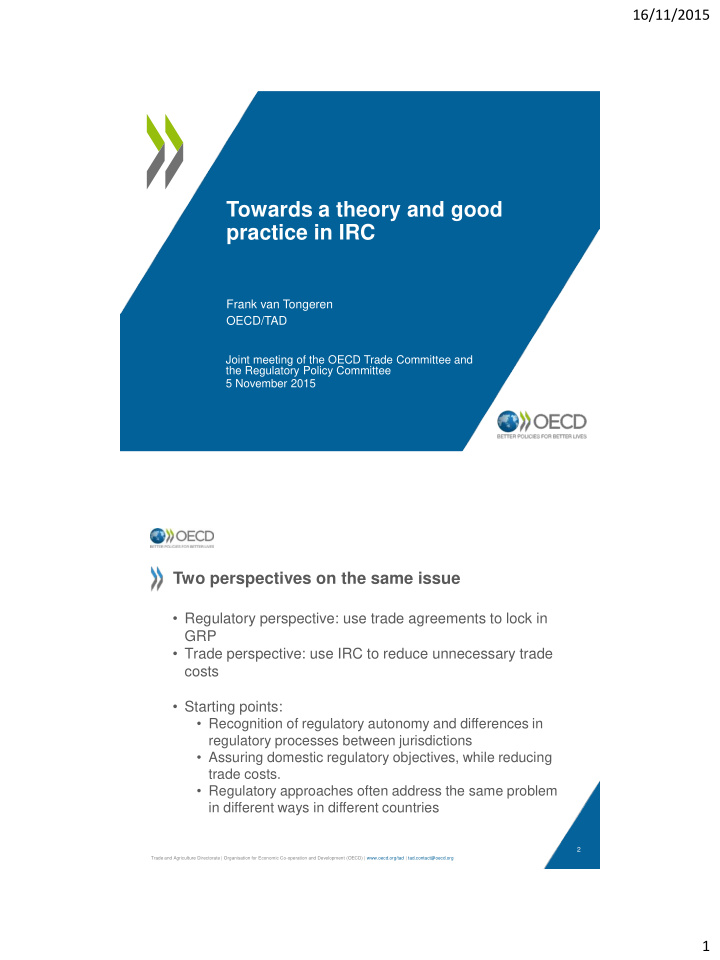



16/11/2015 Towards a theory and good practice in IRC Frank van Tongeren OECD/TAD Joint meeting of the OECD Trade Committee and the Regulatory Policy Committee 5 November 2015 Two perspectives on the same issue • Regulatory perspective: use trade agreements to lock in GRP • Trade perspective: use IRC to reduce unnecessary trade costs • Starting points: • Recognition of regulatory autonomy and differences in regulatory processes between jurisdictions • Assuring domestic regulatory objectives, while reducing trade costs. • Regulatory approaches often address the same problem in different ways in different countries 2 Trade and Agriculture Directorate | Organisation for Economic Co-operation and Development (OECD) | www.oecd.org/tad | tad.contact@oecd.org 1
16/11/2015 Example: Chocolate standards in Europe The industrial revolution and science allowed testing of the ingredients in food /chocolate in the 19 th century • Showed that adulteration was widespread, not just with cheap substitutes, but also with poisonous ingredients => Public outrage induced regulations and standards But: different regulatory approaches • Ex France vs UK vs Germany 3 Trade and Agriculture Directorate | Organisation for Economic Co-operation and Development (OECD) | www.oecd.org/tad | tad.contact@oecd.org Three approaches to Chocolate regulation 1. Britain: negative- list approach • 1860/75 : general food safety laws • sale of adulterated food 'injurious to health' was forbidden • labelling of (safe) ingredients was mandatory. • Cacao Butter Equivalents (CBEs: non-cacao vegetable fats) were not forbidden 2. France: recipe approach • 1910: Positive list of ingredients plus composition • Defines ‘quality’ 3. Germany: private standards and regulation • 1879 General food laws + industry standards (negative-list) • From 1933: Private standards (recipes) become basis for regulation 4 Trade and Agriculture Directorate | Organisation for Economic Co-operation and Development (OECD) | www.oecd.org/tad | tad.contact@oecd.org 2
16/11/2015 A 30-year Chocolate War in Europe 1957: • The six founding EU members had chocolate regulations close to the French model. • The new EU chocolate standards are very close to the 1910 French approach 1973: • UK, Ireland and Denmark join. Their chocolate follows the British model (and allows CBEs) 1980s and 1990s: • More countries join and it becomes close to 50/50. 2003 (After 30 years !): • A compromise : CBEs are allowed up to 5% in all of the EU • Most chocolate companies stick to their pre-2003 strategies & use the “traditional way” as a quality signal 5 Trade and Agriculture Directorate | Organisation for Economic Co-operation and Development (OECD) | www.oecd.org/tad | tad.contact@oecd.org Post script: international chocolate spillovers • In 2003 Codex Alimentarius revised its chocolate standard to allow the use of up to 5% of vegetable fat – in line with EU legislation Like to taste more? See: Swinnen and Squicciarini (Eds.), 2015, The Economics of Chocolate , Oxford University Press 6 Trade and Agriculture Directorate | Organisation for Economic Co-operation and Development (OECD) | www.oecd.org/tad | tad.contact@oecd.org 3
16/11/2015 The way forward • we need a theory: understand which IRC mechanisms work and when • different regulatory approaches lead to alternative distributions of costs and benefits for consumers, producers and the government • understanding and dealing with distributional effects is key to constructive IRC solutions • we need observations: existing IRC mechanisms • inherently sector/issue specific • we know more about trade effects of lack of IRC than about benefits of IRC 7 Trade and Agriculture Directorate | Organisation for Economic Co-operation and Development (OECD) | www.oecd.org/tad | tad.contact@oecd.org The way forward - 2 • We need practical conclusions: a tool to guide negotiators and regulators through the options available • Progress can be made on two fronts: • Instruments to reduce trade costs related to existing ‘stock’ of regulations and NTMs • some form of ‘mutual equivalence’, transparency provisions, international standards etc • Innovative solutions to better design future regulations • agreements on process for co-designing regulations • Extended GRP? • Joint bodies – but which mandate would they have? Which participation? 8 Trade and Agriculture Directorate | Organisation for Economic Co-operation and Development (OECD) | www.oecd.org/tad | tad.contact@oecd.org 4
16/11/2015 Contact us We look forward to hearing from you! Access all of the You can reach us via We invite you to connect information from the e-mail by sending your with us on Twitter by Trade & Agriculture message to the following following: Directorate at: address: www.oecd.org/tad tad.contact@oecd.org @OECDagriculture 9 9 9 Trade and Agriculture Directorate | Organisation for Economic Co-operation and Development (OECD) | www.oecd.org/tad | tad.contact@oecd.org 5
Recommend
More recommend